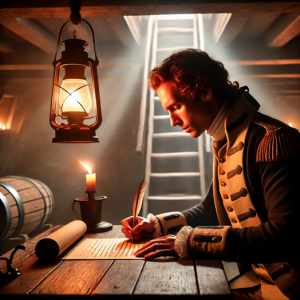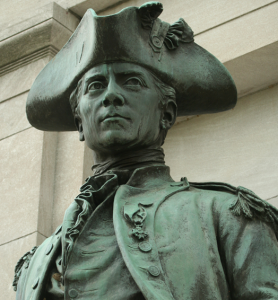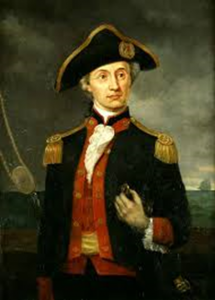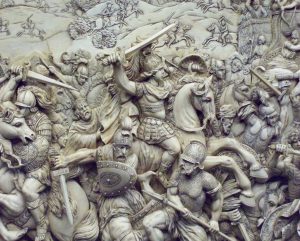The vast grey skies stretched endlessly above the cold North Sea. Waves crashed against the Bonhomme, commanded by none other than John Paul Jones. The air was heavy with tension as, from a distance, two British ships approached the Bonhomme. The two British ships were part of a supply chain and provided aid and support to the British Navy. However, Jones’ immediate target was not the supply ships but the heavily armored battleship, the HMS Serapis. Jones, analyzing the battlefield, recognized the disadvantage his older and slower ship had. Nevertheless, the opportunity to strike a blow to the most powerful navy in the world was too good to pass up. With fire in his eyes, he gave the order, “Prepare for battle.”1

Jones, feeling the pressure as the HMS Serapis moved closer, assessed the situation. His poor, non-maintained 42 guns were no match for the new, well-maintained 50 guns the HMS Serapis had. Any captain would not only turn and retreat but would think of the lives of his crew, to not put them in any unreasonable danger; but this is the relentless, bold, and pirate-like John Paul Jones. The crew, rightfully nervous, doubted their ability to fight a vastly superior foe. Jones rallied his men and shouted, “We fight not for glory, but for freedom.” The men, still uneasy, readied the ship, while Jones fixed his mind on only one thing: battle. 2
As the ships slowly approached each other, the tension among the crew aboard the Bonhomme almost became visible to the naked eye. The men showed an array of emotions, from fury to fear. Many men have not fought a single battle yet; they were rookies with no experience preparing them for what was to come. According to Jones’s own accounts, the sight of the looming Serapis was enough to shake even the bravest among them.3 Still, Jones pushed through the fear, like the strong leader he was, and continuously reassured the men through his words. Jones knew one of the only things that could keep the American dream alive was confidence. Clare Brandt describes Jones by his striking ability to do these things through his personality alone.4
As the two ships approached, the Serapis took advantage, blasting their firepower right at the Bonhomme. The first round devastated the ship, blistering the deck apart. Jones, unfazed by this farce, ordered his men to return fire 5 However, the older guns burst, rendering them useless as well as killing some of his best men. The Serapis closed the distance; however, this was unfolding perfectly for Jones; he knew he could not exchange blows with the Serapis with what he had left; however, he could neutralize the Serapis’s firepower through close-quarters combat, for if they would fire at such a short distance, not only would they damage the Bonhomme but also themselves. 6 The ships were connected, as Jones used grappling hooks to pull them together. The crewmates, as well as Jones, felt the stakes rise; their ship had taken too much damage, and time was now another factor in this fight.
The battle raged on, and the captain of the Serapis, Captain Pearson, called for Jones, shouting for his surrender. The Bonhomme had already taken too much damage, and the crewmates were barely holding the line. Yet Jones stood there, surrounded by bursts of flames and fallen crewmates shouting what would be heard for all of history: “I have not yet begun to fight!” 7 The stubbornness of this man rekindled the fighting spirit of the men as they fought the inordinate odds. Evan Thomas explains it as the clear moment we can see Jones’ willingness to fight and his denial to lose heart in this battle. This was the catalyst of the battle and was one of the sole reasons it continued.

As the ships were close together, the “Serapis had the advantage of her two batteries, besides the cannon on the quarterdeck and on the forecastle.”8 The Bonhomme had only its four pieces on the quarterdeck, which, during the chaos, was abandoned for some time. Throughout the evening, the obvious yellow-painted Serapis had been repeatedly blasted and now sat in flames, in the same state as the Bonhomme. The men aboard the Bonhomme strategically supported the cannons with musket fire and grenades so that those holding the stations aboard the Serapis would flee, leaving no return fire. Richard Pearson, considering the possibility of surrender, opted for a way out of his gruesome predicament. One of the pumps on the Bonhomme was cut with a stay-musket bullet. The master carpenter saw this clear breakage and cried out to the leaders that the ship was then sinking. Among the chaos of the fatal blows taken on both ends, misinformation about the many casualties began to spread. Rumor had it that both the lieutenant and Jones were killed, leaving the chief gunner to think he had come into a new position of power. He began ordering the men around, demanding they bring down the American flag. When Jones heard of this, he was rightfully confused, as he had ordered his men to do no such thing. Jones was certainly not dead, but merely on the front lines, firing off cannons and defending the ship. The Alliance, La Pallas, and Countess of Scarborough supported the ships of Jones that were off to the side of the battle. As the battle commenced, the captain of La Pallas first talked to the captain of the Alliance. Following that, he spoke with the captain of the Countess of Scarborough. Each ship followed each other until they were on the broadside of the Serapis and began delivering cannon fire and delivering blow after blow to enemy ships. The ships sailed off, waiting for when they would be called upon again to save the Bonhomme from further cannon damage.9
As the fighting continued, barrages of cannon fire were exchanged between the ships. Rumors spread that the Bonhomme would sink, prompting the masters at arms to open the cells of the prisoners below. When the newly released prisoners stepped outside the ship and were exposed to the fighting outside, they realized that escaping was not an option. Jones was enraged and began to speculate on his next move; he knew amassing the prisoners back to their cells wasn’t an option. It would leave the Serapis to take advantage of the opportunity and deliver a defeating blow every second they were gone from their stations. Instinctively, he put them to work, and luckily enough, they didn’t revolt. The exchange of blows from grenades, musket fire, and cannons persisted. “As the three guns of the Bonhomme continued to fire without interruption against the Serapis and finally cut down the railing on her quarterdeck and her mainmast” 10 The firing rate slowed for the Serapis; men lost morale as victory was but a thread of hope. William Hamilton, a Scottish man, was arguably one of the best fighters on the Bonhomme. He climbed the main mast so he could see everyone below; his strategy was simply that if he saw a cluster of men, he would throw a grenade, causing severe damage. Hamilton was “skillful enough to throw several into their hatchways, and one of them set fire to the charge of an 18-pounder on the first gundeck, burning several people.” 11
The battle was decided as the captain of the Serapis approached the upper deck; the ships were so close to one another that the captain could walk onboard the Bonhomme. He, along with a delegation of his highest-ranking crewmembers, met with Jones, and the captain, waving the white flag and admitting defeat, presented Jones with his battle sword. The battle ended at “11 o’clock; consequently, it had lasted more than four hours.”12 Meanwhile, the Bonhomme had 322 men, many untested in any battle. The Serapis were undoubtedly better in every way, from equipment to artillery; truly, the Bonhomme was no match. With the support of the Alliance and Lavengence, victory would sway back and forth between the two now almost equal forces. However, Lieutenant Henry Lunt “strategically” waited in the distance for a call for help.
After the battle had concluded, the battlefield was equally as dangerous as it was at the height of the fighting. Fires were raging, doused with water repeatedly by both parties to control them; for hours this continued during the fight until they were extinguished. The weather was fair during the fight, but the hours after the fight were very different; winds arose, causing the fires to reignite. To make it worse, a surplus of gunpowder was left over. If the two were to mix, explosion and devastation would surely be inevitable. The men worked quickly to move the barrels and douse the fires yet again. The following day, Jones took the liberty of examining the Bonhomme. The remnants he found were devastating. He moved to the captured Serapis and slowly through the day watched as it sank. The Serapis headed for Texas, where some 600 prisoners would be escorted to a new ship with better equipment prepared for Captain Jones. Personal belongings of Captain Pearson as well as his entourage were returned. Sometime after, John Paul Jones was awarded a knighthood for his impressive valor in England. 13

- John Paul Jones, Memoir of the American Revolution: Presented to King Louis XVI of France and the American People (Norfolk, VA: The Donning Company, 1979), 24. ↵
- John Paul Jones, Memoir of the American Revolution: Presented to King Louis XVI of France and the American People (Norfolk, VA: The Donning Company, 1979), 26. ↵
- John Paul Jones, Memoir of the American Revolution: Presented to King Louis XVI of France and the American People (Norfolk, VA: The Donning Company, 1979), 92. ↵
- Clare Brandt, John Paul Jones (New York: Penguin Books, 2001), 32. ↵
- John Paul Jones, Memoir of the American Revolution: Presented to King Louis XVI of France and the American People (Norfolk, VA: The Donning Company, 1979), 34. ↵
- John Paul Jones, Memoir of the American Revolution: Presented to King Louis XVI of France and the American People (Norfolk, VA: The Donning Company, 1979), 33. ↵
- Clare Brandt, John Paul Jones (New York: McGraw-Hill, 1990), 124. ↵
- Clare Brandt, John Paul Jones (New York: McGraw-Hill, 1990), 34. ↵
- John Paul Jones, Memoir of the American Revolution: Presented to King Louis XVI of France and the American People(Norfolk, VA: The Donning Company, 1979), 35. ↵
- John Paul Jones, Memoir of the American Revolution: Presented to King Louis XVI of France and the American People(Norfolk, VA: The Donning Company, 1979), 33. ↵
- John Paul Jones, Memoir of the American Revolution: Presented to King Louis XVI of France and the American People(Norfolk, VA: The Donning Company, 1979), 38. ↵
- John Paul Jones, Memoir of the American Revolution: Presented to King Louis XVI of France and the American People (Norfolk, VA: The Donning Company, 1979), 39. ↵
- John Paul Jones, Memoir of the American Revolution: Presented to King Louis XVI of France and the American People (Norfolk, VA: The Donning Company, 1979), 44. ↵



2 comments
Boston Babiarz
I appreciate the vivid imagery and emotional depth conveyed in the narrative, which effectively captures the tension and bravery of John Paul Jones and his crew. The historical context adds richness to the story. One minor suggestion would be to streamline some sentences for clarity, ensuring the pacing maintains the gripping tension throughout the battle.
Natalia De la garza
Thank you for this incredible piece I absolutely loved it! The way you vividly captured the tension, bravery, and high stakes surrounding John Paul Jones and the Bonhomme is truly remarkable. Your storytelling brought the historical moment to life, immersing the reader in the drama of the impending battle. It’s clear you poured a lot of effort into this, and it shows amazing work